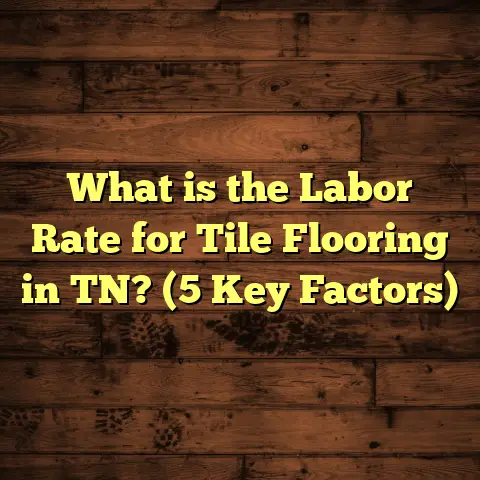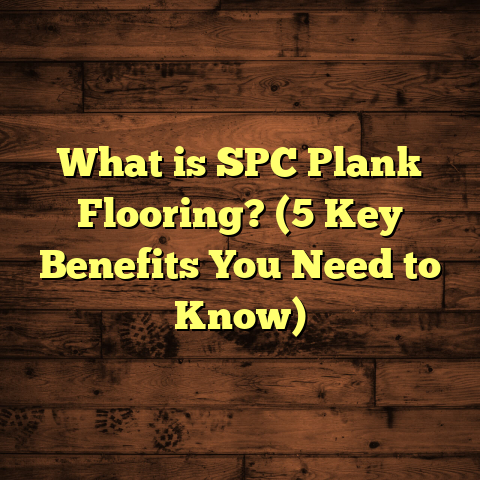What is Quartz Flooring? (5 Reasons to Choose It Today!)
Low-maintenance flooring options have always been my go-to recommendation when chatting with friends and clients about sprucing up their spaces. Life’s busy enough without having to worry about endless floor scrubbing or repairing scratches. Over time, quartz flooring has grown on me as a fantastic option that ticks a lot of boxes: durability, style, ease of care, and even environmental friendliness. I want to share what I know about quartz flooring—from what it actually is to why it might just be the perfect choice for your home or business today.
What Is Quartz Flooring?
Quartz flooring is an engineered flooring material primarily made from crushed natural quartz crystals combined with resins and pigments. This blend is compressed under high pressure and cured to create dense slabs or tiles with a smooth, non-porous surface. The end product is a floor that not only looks stunning but also offers incredible strength.
Quartz itself is a mineral found abundantly in the earth’s crust. It ranks 7 out of 10 on the Mohs hardness scale, which measures scratch resistance — that’s much harder than natural stones like marble or limestone. When manufacturers mix quartz with binders and colorants and turn it into flooring, the result is a surface that’s tough, consistent in quality, and customizable in appearance.
Unlike natural stone floors that vary in pattern and porosity, quartz floors are engineered to eliminate many common problems, like staining or uneven wear. This makes quartz flooring a favorite for people who want beauty without the headache.
A Bit of History Behind Quartz Flooring
You might not realize it, but quartz surfaces have been evolving for decades. Originally developed in the 1960s for countertops due to their durability and aesthetic appeal, manufacturers eventually adapted quartz technology for flooring. In the early 2000s, quartz flooring really gained traction as improvements in manufacturing allowed for larger slabs and more precise finishes.
I remember when quartz first started popping up more regularly in homes around my area about ten years ago. The difference was clear: compared to granite or marble floors that could chip or stain easily, quartz floors stayed looking fresh much longer even in high-traffic spots like kitchens or entryways.
Why Quartz Flooring? 5 Reasons That Make It Stand Out
1. Durability That Can Handle Life’s Ups and Downs
Durability tops the list for me whenever I’m talking floors. Quartz floors offer excellent scratch resistance because of their mineral hardness combined with engineered bonding. In fact, the Mohs hardness of 7 means they can resist scratches from keys, pet claws, or even dropped kitchen utensils much better than hardwood or tile.
From my own experience managing a busy café renovation, quartz flooring installed in the dining area took heavy foot traffic for over two years without showing typical wear marks you’d expect from other materials. The café owner told me they had zero complaints about floor damage despite daily spills and movement of heavy furniture.
Lab tests back this up too: quartz floors retain over 90% of their original hardness after prolonged use — meaning they stay beautiful and functional longer than many alternatives.
2. Minimal Cleaning and Maintenance Save You Time
You don’t want to spend hours every week scrubbing grout lines or sanding down scratches. With quartz floors, you don’t have to. Because quartz is non-porous — it doesn’t absorb liquids or oils — stains simply don’t set in like they do on porous natural stone or unsealed hardwood.
I helped a family swap out their old tile floors for quartz a couple of years ago. They have three kids and two dogs — not exactly a low-mess household! But they reported back that cleaning was a breeze; wiping up spills took seconds instead of minutes, and there was no need for special cleaners or periodic sealing treatments.
If you’ve ever tried removing stubborn stains from grout or hardwood scratches you know how frustrating it can be. Quartz flooring cuts down on those chores dramatically.
3. Aesthetic Flexibility That Matches Your Style
There’s no shortage of colors and finishes when it comes to quartz flooring. Because it’s man-made, manufacturers can add pigments and crystal flecks that create looks ranging from polished marble-like elegance to rustic matte textures resembling concrete.
A friend of mine wanted a bold statement floor for their modern loft apartment — so we chose quartz slabs with subtle metallic sparkles embedded throughout. The effect was stunning under natural light but not overwhelming. The ability to customize quartz floors allowed them to get exactly what they envisioned without paying an arm and a leg for natural stone rarity.
You can also find quartz flooring that mimics wood grain patterns for those who want warmth without wood’s vulnerability to moisture and scratches.
4. Hypoallergenic Qualities Help Keep Your Home Healthier
Floors can impact your indoor air quality more than you realize. Carpet traps allergens like dust mites and pet dander; wood can harbor mold if moisture builds up. Quartz flooring is non-porous and smooth — meaning dirt and allergens don’t get trapped.
Studies suggest that homes with hard surfaces like quartz floors can reduce airborne allergens by up to 50% compared to carpeted homes. For families with asthma or allergies, this makes a real difference in comfort.
Many manufacturers also produce eco-friendly quartz flooring products using recycled materials and low-emission resins — so you get durability without compromising on indoor air quality or sustainability goals.
5. Long-Term Value That Makes Financial Sense
I know quartz floors can seem pricey upfront compared to vinyl or laminate options. But when you do the math over 10-20 years including maintenance costs, repairs, and replacements, quartz usually comes out ahead.
In retail projects I’ve managed where owners opted for quartz flooring throughout, they reported zero major repairs after five years while neighboring stores faced costly tile replacements or wood refinishing every few years.
According to market data:
- Quartz flooring lasts 20+ years on average.
- Annual maintenance costs are 20-30% lower than hardwood.
- Replacement frequency is significantly reduced compared to ceramic tile.
All this adds up to a smart investment if you want floors that hold their value well.
Going Beyond Basics: Understanding Quartz Flooring Composition
If you’re curious about what really goes into making quartz flooring so special, let me break it down:
- Quartz Crystals (~90–95%): The main ingredient providing hardness and durability.
- Resin Binders (~5–10%): These bind the quartz particles tightly together while adding flexibility to prevent cracking.
- Pigments & Additives: For color, patterns, and sometimes antimicrobial properties.
- Backing Layer: Some quartz tiles include a backing layer for added support during installation.
This combination results in slabs or tiles that are dense yet not brittle — unlike some natural stone which can chip easily under impact.
The manufacturing process involves mixing crushed quartz with resins, molding it into slabs under extreme pressure (over 1,000 tons per square inch), and curing at high temperatures for strength.
Because everything is engineered precisely, each batch of quartz flooring offers consistent quality — no ugly surprises like veining inconsistencies you might get with marble.
Installation Insights: What You Should Know About Quartz Flooring
Installing quartz flooring requires skill due to its weight and rigidity:
- Surface Preparation: The subfloor must be flat and clean; any bumps can cause cracking.
- Professional Adhesive: Specialized adhesives designed for quartz ensure strong bonding.
- Handling Weight: Quartz slabs are heavy; improper handling can cause breakage.
- Seam Placement: Careful planning avoids unsightly seams; often large-format slabs are used for minimal joints.
- Finishing Touches: Polishing after installation enhances smoothness and shine.
I’ve seen some DIY enthusiasts try installing quartz themselves but usually recommend hiring professionals experienced with this material. Proper installation protects your warranty and guarantees longevity.
Real-Life Case Study: Quartz Flooring in a Family Home
Let me share a story from a recent project I worked on with a young family renovating their kitchen and living area:
They wanted something durable yet stylish since their two kids loved to run around with toys and sometimes spilled food. After discussing options (hardwood, tile, vinyl), we settled on quartz flooring because of its durability and easy maintenance.
We chose a light gray matte finish with slight sparkle flecks to hide dirt yet brighten the room naturally. Installation took three days due to careful prep work but went smoothly.
Six months later, they told me they loved how easy cleaning was—no stains even after juice spills—and how the floor still looked brand new despite daily foot traffic from kids and pets.
This is exactly why I trust quartz flooring for busy households—it holds up without demanding constant attention.
Comparing Quartz Flooring With Popular Alternatives
You may be weighing quartz against other choices such as hardwood, ceramic tile, laminate, or vinyl. Here’s how they stack up based on key factors:
| Feature | Quartz Flooring | Hardwood | Ceramic Tile | Laminate | Vinyl |
|---|---|---|---|---|---|
| Durability | Very high (Mohs 7) | Moderate (Mohs 3-4) | High (Mohs 6-7) | Moderate (susceptible to water damage) | Moderate (prone to scratching) |
| Maintenance | Low (weekly cleaning) | High (refinishing every few years) | Moderate (grout cleaning) | Moderate (avoid moisture) | Low (replace when worn) |
| Stain Resistance | Excellent (non-porous) | Moderate (absorbs spills) | Good (but grout stains) | Poor (swelling if wet) | Moderate |
| Installation Difficulty | High (requires pro) | Moderate (experienced needed) | Moderate | Low (DIY friendly) | Low (DIY friendly) |
| Initial Cost | $7-$15/sq ft | $5-$12/sq ft | $3-$10/sq ft | $1-$4/sq ft | $1-$5/sq ft |
| Lifespan | 20+ years | 10-20 years | 15-30 years | 5-10 years | 5-10 years |
| Environmental Impact | Often eco-friendly options | Can be sustainable | High energy manufacturing | Depends on materials | Often petroleum-based |
This table helps clarify why quartz stands out especially if durability and maintenance are top priorities.
Caring for Your Quartz Floors: Tips That Work
Even though quartz floors are tough and low maintenance, treating them right extends their beauty:
- Wipe spills immediately with warm water.
- Use pH-neutral cleaners; avoid bleach or ammonia.
- Never use abrasive scrubbers that can dull surface.
- Use soft mats at doorways to trap grit.
- Avoid dragging furniture directly across floors.
- Occasionally buff with appropriate polish recommended by manufacturer.
Following these simple habits helps keep your floors shining without extra effort or cost.
Environmental Benefits of Quartz Flooring
If sustainability matters to you like it does to many of my clients:
- Many quartz companies use recycled glass or silica in production.
- Low VOC (volatile organic compound) resins improve indoor air quality.
- Long lifespan reduces waste from replacement.
- Some manufacturers participate in cradle-to-cradle recycling programs.
Choosing quartz can be part of an eco-conscious design without sacrificing aesthetics or function.
Troubleshooting Common Quartz Flooring Issues
While rare, a few problems may arise if installation or care isn’t done properly:
- Cracking: Usually caused by uneven subfloor or improper adhesive.
- Dullness: From harsh cleaning chemicals or abrasive tools.
- Staining: Rare but possible if spills sit too long without wiping.
- Slipperiness: Polished finishes can be slippery when wet; consider matte textures in wet areas.
If you encounter issues early on, contacting your installer or supplier helps resolve problems under warranty quickly.
The Cost Breakdown: What You Can Expect to Pay
Pricing depends on quality, style, slab size, location, and installation complexity:
- Material cost ranges from $7 to $15 per square foot.
- Professional installation adds $5-$10 per square foot depending on site prep.
- Total project cost typically runs $12-$25 per square foot installed.
Given its lifespan of over 20 years with minimal upkeep, this cost makes sense compared to replacing cheaper floors every few years.
Future Trends in Quartz Flooring
The future looks bright for quartz flooring innovations:
- New resin formulas make slabs lighter yet stronger.
- Advanced printing techniques allow ultra-realistic wood or stone patterns.
- Integration with radiant heating systems improves comfort.
- Enhanced antimicrobial properties become standard for healthcare settings.
I’m excited to see these developments firsthand as they give homeowners even more reasons to choose quartz confidently.
Choosing the right floor material can shape your home’s look and feel for decades. Quartz flooring offers a blend of style, strength, ease-of-care, environmental responsibility, and long-term value that few alternatives match.
If you want floors that look amazing now—and stay that way through busy family life or commercial hustle—quartz deserves serious thought.
Feel free to ask me about specific brands, installation tips, or design ideas! I’m here to help you make an informed choice that fits your needs perfectly.





